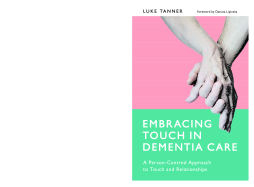
Additional Information
Book Details
Abstract
Meaningful touch is an essential part of truly person-centred dementia care, yet its value is often viewed as secondary to its perceived risks. This book restores trust in the power of touch, demonstrating the vital role it plays in supporting personhood, relationships and wellbeing, and challenging the barriers preventing staff from using touch in meaningful ways.
Using many examples from practice, Luke Tanner demonstrates that touch and other forms of non-verbal communication are essential for 'being with' and not just 'doing to' people living with a dementia, and explains how and when to use touch effectively in everyday interactions, and in all stages of dementia. He places touch in the context of consent and safeguarding, whilst emphasising the need for positive attitudes to touch to be at the heart of care cultures.
Offering perspectives, ideas, training exercises and culture change actions to maximise the benefits of touch in dementia care settings, this practical guide will enable practitioners to reflect on their own use of touch and develop the knowledge, skills and confidence to place meaningful touch at the heart of their work.
Individual person-centred care is a key aspect of improving the quality of life for people with dementia. There are many approaches to this and having a range of techniques available that can help, where appropriate, to improve relationships are key. Luke Tanner should be congratulated at describing, so adroitly, touch as one such approach.
Alistair Burns, Professor of Old Age Psychiatry, University of Manchester
Extremely thought-provoking and informative ... I look forward to sharing this book with my team.
Anita Astle MBE, Registered Nurse & Manager of Wren Hall Nursing Home, Nottingham
Embracing Touch in Dementia Care challenges the reader to explore their current practice, thoughts, and feelings about the experience of touch and relationships in dementia caregiving. This book isn't just about when and where it is appropriate to offer someone receiving care a hug. Readers are encouraged and supported with practical examples and exercises they can use with their colleagues, to explore the wide variety and symbolism of the types of touch we experience daily as human beings, and its relevance and importance to our wellbeing and sense of self. [...] This book will be referred to and revisited by readers as they develop their skills and understanding.
Suzanne Mumford, principal consultant, The Journal of Dementia Care
Luke Tanner is a massage therapist, body psychotherapist and dementia care trainer. He specialises in the use of touch and non-verbal communication to support the wellbeing of people with a dementia living in residential care settings. He lives in London. More information about Luke's work can be found at www.touchincare.com.
Luke Tanner has discovered a profound and deep appreciation of the use of touch to sustain and regain human connection through all stages of dementia. He uses his knowledge and skill to help others develop new awareness, knowledge, and ability. He provides practical and effective strategies to help a community leader guide individual staff from caregiving to care partnering with individuals living with dementia through structured personal learning opportunities. Luke's work supports authentic person-centered dementia care culture training!
Teepa Snow, Internationally respected educator on dementia and creator of the dementia care consultancy, Positive Approach™ to Care
This book on 'embracing touch' is a welcome addition to our field. It celebrates the potential of touch while also confronting its challenges. This books helps to ensure that touch takes its rightful places as integral to person-centred care.
Dr Murna Downs, Head of the School of Dementia Studies, University of Bradford
Table of Contents
| Section Title | Page | Action | Price |
|---|---|---|---|
| Embracing Touch in Dementia Care - A Person-Centred Approach toTouch and Relationships, by Luke Tanner | 3 | ||
| Foreword | 9 | ||
| Acknowledgements | 12 | ||
| Introduction | 15 | ||
| 1. Models of Care and Cultures of Touch | 23 | ||
| 2. Talking About Touch in Care | 35 | ||
| 3. The Experience of Touch and Cognitive Impairment | 47 | ||
| 4. A Sense of Touch and the Experience of Attachment | 58 | ||
| 5. Touch, Confusion and Uncertainty | 73 | ||
| 6. Non-Verbal Consent to Touch | 82 | ||
| 7. Touch, Emotional Needs and Personhood | 89 | ||
| 8. Touch, Relationships and Intimacy | 101 | ||
| 9. Touch in Care Tasks | 115 | ||
| 10. Resistance to Touch in Care Tasks | 131 | ||
| 11. Erotic Touch and Sexual Intimacy | 151 | ||
| 12. Being in Touch with Stuff | 172 | ||
| 13. Conclusion | 192 | ||
| Appendix 1 - The Touch Observational Tool | 199 | ||
| Appendix 2 - Outline of Classifications Used in the Quality of Touch Schedule | 214 | ||
| Appendix 3 - Touch Observation Sheet | 216 | ||
| Appendix 4 - Touch Observation Summary Sheet | 217 | ||
| Appendix 5 - Five Touch \nTraining Exercises: \nA Step‑By-Step Guide | 218 | ||
| Appendix 6 - Trust in Touch Checklist | 235 | ||
| References | 239 | ||
| Further Reading | 243 | ||
| Index | 248 | ||
| Blank Page |
